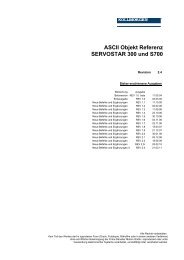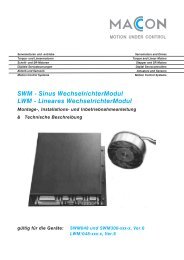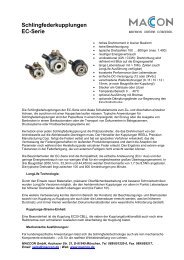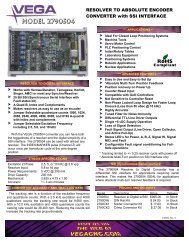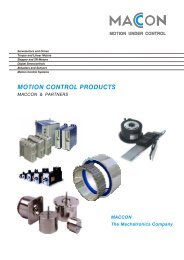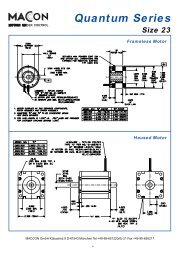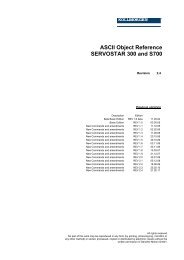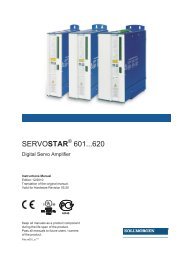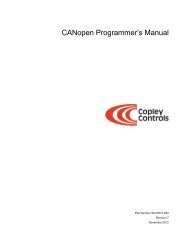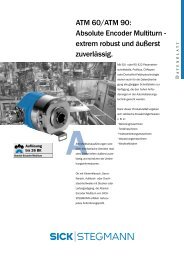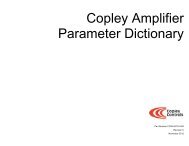Datasheet Stepnet Panel - Maccon.de
Datasheet Stepnet Panel - Maccon.de
Datasheet Stepnet Panel - Maccon.de
Create successful ePaper yourself
Turn your PDF publications into a flip-book with our unique Google optimized e-Paper software.
GROUNDING CONSIDERATIONS<br />
Power and control circuits in <strong>Stepnet</strong> share<br />
a common circuit-ground (Gnd on J1-4,<br />
Signal Ground on J3-7 & 25 and J4-3 & 4).<br />
Input logic circuits are referenced to Signal<br />
Ground, as are power GND, digital outputs,<br />
and enco<strong>de</strong>r. For this reason, drive Gnd<br />
terminals should connect to the users’ common<br />
ground system so that signals between<br />
drive and controller are at the same common<br />
potential, and to minimize noise. The<br />
system ground should, in turn, connect to<br />
an earthing conductor at some point so that<br />
the whole system is referenced to “earth”.<br />
The CAN ports are optically isolated from<br />
the drive circuits.<br />
Because current flow through conductors<br />
produces voltage-drops across them, it is<br />
best to connect the drive HV GND to system<br />
earth, or circuit-common through the shortest<br />
path, and to leave the power-supply<br />
floating. In this way, the power supply (-)<br />
terminal connects to ground at the drive<br />
HV Return terminals, but the voltage drops<br />
across the cables will not appear at the drive<br />
ground, but at the power supply negative<br />
terminal where they will have less effect.<br />
For CE compliance drive cables should be<br />
shiel<strong>de</strong>d. Motor phase currents are balanced,<br />
but currents can flow between the<br />
PWM outputs, and the motor cable shield.<br />
<strong>Stepnet</strong> <strong>Panel</strong><br />
Drive<br />
To minimize the effects of these currents<br />
on nearby circuits, the cable shield should<br />
connect to Frame Gnd (J2-1). Power supply<br />
wiring should also be shiel<strong>de</strong>d and shield<br />
connected to J1-1, and pin 9 of J3 connects<br />
the control cable shield to frame ground. The<br />
drive case (Frame Ground, or F.G.) does not<br />
connect to any drive circuits. Connections to<br />
F.G. are provi<strong>de</strong>d on connectors J1-1, J2-1,<br />
and J3-9. When installed, the drive case<br />
should connect to the system chassis. This<br />
maximizes the shielding effect of the case,<br />
and provi<strong>de</strong>s a path to ground for noise currents<br />
that can occur in the cable shields.<br />
Signals from controller to drive are referenced<br />
to +5 Vdc, and other power supplies<br />
in user equipment. These power supplies<br />
should also connect to system ground and<br />
earth at some point so that they are at<br />
same potential as the drive circuits. The<br />
final configuration should embody three<br />
current-carrying loops. First, the power<br />
supply currents flowing into and out of the<br />
drive at the +HV and Gnd pins on J1. Second<br />
the drive outputs driving currents into and<br />
out of the motor phases, and motor shield<br />
currents circulating between the A+, A-,<br />
B+, & B- outputs and Gnd. And, lastly, logic<br />
and signal currents connected to the drive<br />
control inputs and outputs.<br />
POWER SUPPLIES<br />
STP<br />
Copley Controls, 20 Dan Road, Canton, MA 02021, USA Tel: 781-828-8090 Fax: 781-828-6547<br />
Web: www.copleycontrols.com Page 9 of 16<br />
RoHS<br />
<strong>Stepnet</strong> operates typically from transformer-isolated,<br />
unregulated DC power supplies.<br />
These should be sized such that the<br />
maximum output voltage un<strong>de</strong>r high-line<br />
and no-load conditions does not exceed the<br />
drives maximum voltage rating. Power supply<br />
rating <strong>de</strong>pends on the power <strong>de</strong>livered to<br />
the load by the drive. Unlike servo motors<br />
that consume little power at a standstill,<br />
steppers dissipate power continuously when<br />
in-position. This can vary from full rated<br />
current in both windings to something less<br />
based on programmed value of holding<br />
current.<br />
Power supplies should be chosen with continuous<br />
power ratings that are sufficient for<br />
the motor in use.<br />
Operation from regulated switching power<br />
supplies is possible if a dio<strong>de</strong> is placed between<br />
the power supply and drive to prevent<br />
regenerative energy from reaching the<br />
output of the supply. If this is done, there<br />
must be external capacitance between the<br />
dio<strong>de</strong> and drive.<br />
AUXILIARY HV POWER<br />
<strong>Stepnet</strong> has an input for AUX HV. This is a<br />
voltage that can keep the drive communications<br />
and feedback circuits active when<br />
the PWM output stage has been disabled<br />
by removing the main +HV supply. This<br />
can occur during EMO (Emergency Off)<br />
conditions where the +HV supply must be<br />
removed from the drive and powered-down<br />
to ensure operator safety. The AUX HV input<br />
operates from any DC voltage that is within<br />
the operating voltage range of the drive and<br />
powers the DC/DC converter that supplies<br />
operating voltages to the drive DSP and<br />
control circuits.<br />
When the drive +HV voltage is greater than<br />
the AUX-HV voltage it will power the DC/DC<br />
converter. Un<strong>de</strong>r these conditions the AUX-<br />
HV input will draw no current.




